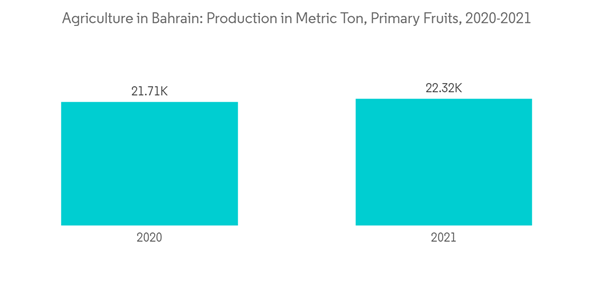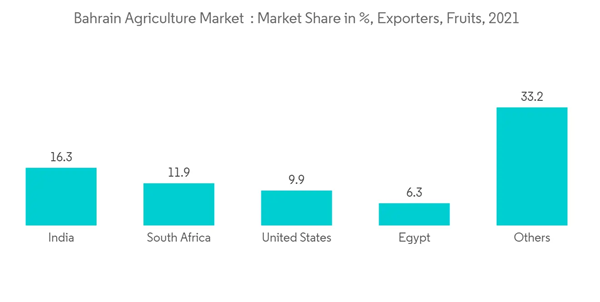Key Highlights
- Bahrain has been a net importer of fruits and vegetables to other gulf member countries and countries in North America and South America due to trade agreements with the countries such as the United States and Saudi Arabia, and the country is one of the major producers of dates globally.
- Bahrain is characterized by high temperatures, limited arable land, water scarcity, and increasing groundwater salinity resulting in limited crops grown in the country. The national government is focusing on intensifying the finance for agriculture and livestock to attract foreign investments for agriculture projects to keep up with local demand.
- The rise in consumption, advanced technologies, and low water requirements for horticulture are the major drivers behind the growth of the market studied. Bahrain has a negligible production of cereals and other agricultural products, contributing to high food imports to meet the local demand. Water constraints and the unavailability of agricultural land are the major constraints in crop production in Bahrain.
Bahrain Agriculture Market Trends
Government Initiative to Boost Domestic Production
- The government has provided subsidies and partnerships with technology companies to increase green cover and production as it highly depends on imports. Alternative production techniques such as hydroponic and aquaponic farming have a lot of plus factors, especially when practiced in an arid environment, such as Bahrain.
- The major crops grown are dates, figs, mangos, pomegranates, melons, papayas, water turnips, potatoes, tomatoes, and produce poultry and dairy products for the local market.
- Bahrain is ramping up efforts to improve food security in the country. The Bahrain government planned a new food security production strategy to increase local production. In 2022, The National Initiative for Agricultural Development (NIAD) was working on several projects that contribute to the support of agricultural workers, increase green spaces, stimulate and support agricultural manufacturing industries, and increase expertise in agriculture through education and training.
- In the project, the authority is working with public and private sector companies to provide the required funding for the Agriculture and Marine Resources Project to establish a plant specialized in producing and packing Bahraini dates in Hoorat A’ali. Therefore, with such initiatives, the market is anticipated to witness growth during the forecasted period.
Decreasing Dependency on Imports
- The hot climate and lack of water resources are the main factors for the region's low agricultural output growth. Bahrain is a net importer of various food grains, but with modern technology, Bahrain is actively trying to tackle the issue of food security. Bahrain imports 90% of its food supplies to meet the demand for RTE salad mix and exotic vegetables such as cherry tomatoes and baby carrots to be available on the hypermarket shelves.
- An increase in population and growing awareness about healthy lifestyles are the factors responsible for the increase in consumption. For instance, in 2021, Serbia exported 839 metric tons of fresh apples to Bahrain and became one of the six largest supplying countries, and Indian farmers exported five varieties of apples to Bahrain, and India emerged as one of the largest exporters with a market share of about 16.3% in 2021.
- However, commercial hydroponic farming facilities are increasing in Bahrain with a promising future. Bahrain is taking definite steps towards self-sustaining certain food items by adopting hydroponic practices. Therefore, adopting new technologies for producing fruits and vegetables is expected to help decrease dependency on imports.
Bahrain Agriculture Industry Overview
Additional Benefits:
- The market estimate (ME) sheet in Excel format
- 3 months of analyst support
This product will be delivered within 2 business days.










